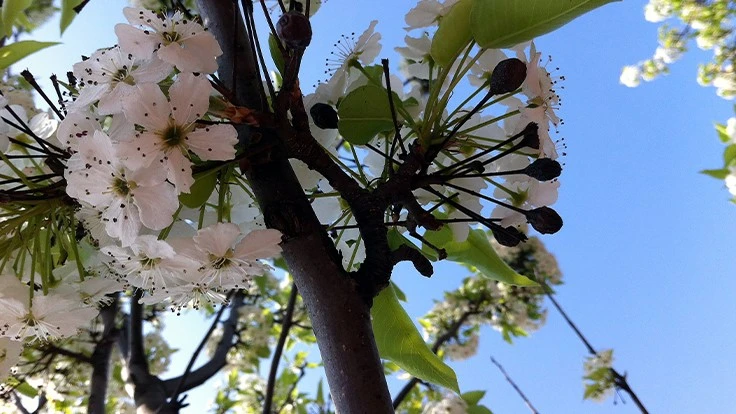
Photo courtesy of Jill Calabro.

It’s common knowledge that certain bacteria can make people sick, but did you know that bacteria can cause plant diseases as well? They most certainly do. The first bacterial pathogen to be identified was anthrax, a disease affecting sheep and cattle in 1876. Shortly after that, the first bacterial plant disease was confirmed – fire blight on apples and pears.
Fire blight is likely native to North America and has colonized most of the U.S. and Canada. While outbreaks are irregular, reports of devastation to apple, pear and other hosts were widespread in 2018, particularly in the Western U.S. Colorado, Washington and California experienced extended favorable weather conditions, and fire blight flourished. Fire blight is very difficult to control once established and can destroy entire orchards in a single season, if conditions are just right.
Infected plant tissue cannot be cured. This is partly due to the fact that fire blight infections extend up to 2-3 feet in wood beyond any visual signs and symptoms. Infected tissue can (and should) be removed and destroyed and clean plant tissue can be protected, but it is likely the tree will harbor the bacteria indefinitely. Disease management, as opposed to control, is key with fire blight.
If you’ve spent any significant length of time with a plant pathologist, you might have heard the phrase “disease triangle.” It’s a model to help visualize how interactions between the plant, environment and a pathogen can result in disease development. For example, if a susceptible host is present (such as Snowdrift crabapple), but the pathogen (in this case a bacterium) is not present or active, then fire blight won’t be a problem. Likewise, if the environment is not conducive to disease (such as hot, dry weather), then fire blight won’t be an issue then either.
Altering one or more of these three factors can impact fire blight development in a positive way for the grower.

Environment
Fire blight depends on favorable weather conditions associated with most springs: namely warm weather (between 65-85°F) accompanied by intermittent rains or high humidity. Throw in a little hailstorm that damages tender shoots, leaving open wounds ideal for pathogen entry, and the environment is prime for infection. While ambient temperatures cannot be altered, humidity can be lowered with techniques such as pruning and weed management. These practices increase airflow, which will help lower disease susceptibility.
Host
Fire blight infects over 200 different species in the Rosaceae family, including crab apples, pears, apples, Pyracantha and blackberry. Some cultivars are more susceptible than others; so, planting cultivars more tolerant of fire blight will help minimize overall damage. Beyond that, the way the host is managed can lower disease severity too. Fire blight prefers succulent growth; therefore, avoid actions that encourage new, vigorous growth, such as excessive nitrogen fertilization, high soil moisture and aggressive pruning. These are all ways to manage the host to slow disease.

Pathogen
In the case of fire blight, the vertex on the disease triangle is the toughest. Most of the plant diseases we know are caused by fungi, which tend to be easier to control with fungicides. Plant diseases not caused by fungi, however, pose a much greater challenge in terms of control. Humans and animals often rely on antibiotics for bacterial disease control and in some situations, antibiotics are used in agriculture, such as citrus greening in oranges. Nursery production and landscape management situations are far less suitable for antibiotic use; so, other control strategies are needed. Copper sprays are somewhat effective against the bacterium, especially to protect new, clean growth, but efficacy is limited under high disease pressure.
Finally, removing the pathogen itself can help reduce inoculum in subsequent growing seasons. Since the pathogen resides in infected plants, cankered tissue should be removed in winter months, when the pathogen is not active, and then destroyed. When removing a cankered branch, find the lowest part of the canker, trace the branch to its point of attachment, and cut at the next branch juncture. In the case of large cankers on trunks, scrape down the bark around the canker to the cambium. Pay attention to wood color as it can be an indicator of infection. Wood directly underneath a canker is usually dead and turns a red color further out, eventually becoming red flecks. Beyond that, the tissue is healthy.
Fire blight is difficult to manage but not hopeless in most years. Management should focus on environment and host modifications as a means of reducing disease pressure. Cultural practices combined with mechanical strategies can help, but in some years (like 2018), almost nothing seems to help.

Explore the October 2019 Issue
Check out more from this issue and find your next story to read.
Latest from Nursery Management
- John Ruter shares UGA's latest woody and herbaceous ornamental plant breeding projects
- Conor Foy joins EHR's national sales team
- Pantone announces its 2026 Color of the Year
- Syngenta granted federal registration for Trefinti nematicide/fungicide in ornamental market
- Get to know Kayela Aeppli
- HILA 2025 video highlights: John Gaydos of Proven Winners
- Q&A with Justin Bartlett
- Be the best choice





